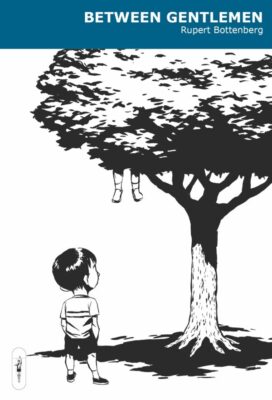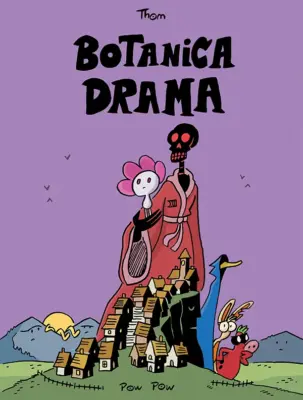
Between Gentlemen
Rupert Bottenberg
Conundrum Press
$10.00
paper
64pp
9781772620900
The story is a sweet one, and illustrated by Bottenberg in soft, choppy black-and-white, but it is clear that written language is something for him to step outside of. Even within “Between Gentlemen,” Magic begins to speak in arcane lettering, for that’s where the magic is. In the other three short stories, Bottenberg talks instead through his medium – ink, white space, the aesthetic play and pleasure of dream language, a well-laid punchline. In his story of Babylon, history is an endless queue of flat hieroglyphic figures, each a practitioner of a different language. The letters crowd in noisy speech bubbles above their heads as the queue climbs the Babylonian tower, and the figure at the top is pushed to their death. We are left with a skull and crossbones, an exclamation, and the toppled 8 of infinity. Everything in Between Gentlemen is at the service of Bottenberg’s ability to suggest a larger world within the brevity of the comic form. It’s a deceptively simple collection of stories, one that seems to change shape after each new read.
Botanica Drama Pow Pow Press
Thom
$29.95
paper
244pp
9782925114314
Up to this point we are moving through a desolate and chiaroscuro story, but with the sun’s first rising over the mountains, Botanica Drama shifts into its main, cutesy style. Because like any cartoon sun, this one has two eyes and a pleasant smile. Fish and mammals and birds begin to evolve in its image, doe-eyed and anthropomorphic. A medieval town is built by the animals, where they drink coffee, watch TV, and carry suitcases to work.
Once in full swing, the novel centres on XIII, or Death, a friendly black skeleton who appeared alongside the first complex life forms, and Philomène, a tiny flower. The two run a café in town and ride from home to work on a moped, the suggestion being that the town runs like clockwork forever, each animal with its own cute job and family. The eventual drama comes not from the town, then, but the sun itself, who refuses to wake one morning from a cosmic hangover. Meaning no daytime, no bright-eyed creatures making pastries, and the return of those gaunt and pale night monsters.
Thom’s incorporation of both light, Looney Tunes comedy and the horrors of a permanent night means the world never becomes maudlin. While in one panel a pig in a military helmet uses a detonator almost as big as he is, another sees the ghostly night figures, opening their heads like black holes to feed on stray rabbits. Reminiscent of the video game Spiritfarer, another tale of gentle death from Montreal, Botanica Drama is at core a love story, charmingly told.mRb






0 Comments